Physical-Mechanical Properties of Chartwell® Coupling Agent-Treated Calcium Carbonate and Silica-Reinforced Hybrid Natural Rubber Composites
Abstract
1. Introduction
2. Experiments
2.1. Materials
2.2. Preparation of the Composites
2.3. Measurements of Curing Characteristics
2.4. Swelling Measurements
- η = crosslink density (mol cm−3);
- χ = polymer-solvent interaction parameter (or Flory parameter);
- ρB = rubber density;
- V0 = molar volume of solvent.
- VB = rubber volume fraction in the swollen form, determined from weight gain by swelling.
- Ρ = sample density (g/cm−3);
- ρL = ethanol density at analysis temperature (g/cm−3);
- mA = wireless sample mass in the air (g);
- mB = wireless sample mass in liquid (g).
2.5. Measurement of Tensile Properties
2.6. Measurement of Hardness (Shore A)
2.7. Measurement of Abrasion-Resistance Properties
- IR = abrasion resistance index in percentage;
- m1 = standard rubber mass (mg);
- mt = test composite mass (mg);
- d1 = standard rubber density (mg cm−3);
- dt = test composite density (mg cm−3).
2.8. Scanning Electron Microscopy (SEM)
2.9. Fourier Transform Infrared (FTIR) Spectroscopy
3. Results and Discussion
3.1. Composites with Calcium Carbonate Only
3.2. Hybrid Composites
3.2.1. Measurement of Curing Characteristics
3.2.2. Swelling Measurements
3.2.3. Measurement of Tensile Properties
3.2.4. Measurement of (Shore A) Hardness and Abrasion-Resistance Properties
3.2.5. Scanning Electron Microscopy (SEM)
3.2.6. Fourier Transform Infrared (FTIR) Spectroscopy
4. Conclusions
Author Contributions
Funding
Institutional Review Board Statement
Informed Consent Statement
Data Availability Statement
Acknowledgments
Conflicts of Interest
References
- Wipatkrut, P.; Poompradub, S. Exfoliation approach for preparing high conductive reduced graphite oxide and its application in natural rubber composites. Mater. Sci. Eng. B 2017, 218, 74–83. [Google Scholar] [CrossRef]
- Wu, X.; Lu, C.; Han, Y.; Zhou, Z.; Yuan, G.; Zhang, X. Cellulose nanowhisker modulated 3D hierarchical conductive structure of carbon black/natural rubber nanocomposites for liquid and strain sensing application. Compos. Sci. Technol. 2016, 124, 44–51. [Google Scholar] [CrossRef]
- Jo, J.O.; Saha, P.; Kim, N.G.; Chang Ho, C.; Kim, J.K. Development of nanocomposite with epoxidized natural rubber and functionalized multiwalled carbon nanotubes for enhanced thermal conductivity and gas barrier property. Mater. Des. 2015, 83, 777–785. [Google Scholar] [CrossRef]
- Dick, T.A.; dos Santos, L.A. In situ synthesis and characterization of hydroxyapatite/natural rubber composites for biomedical applications. Mater. Sci. Eng. C 2017, 77, 874–882. [Google Scholar] [CrossRef]
- Dias, F.J.; Issa JP, M.; Coutinho-Netto, J.; Fazan VP, S.; Sousa, L.G.; Iyomasa, M.M.; Watanabe, I. Morphometric and high-resolution scanning electron microscopy analysis of low-level laser therapy and latex protein (Hevea brasiliensis) administration following a crush injury of the sciatic nerve in rats. J. Neurol. Sci. 2015, 349, 129–137. [Google Scholar] [CrossRef] [PubMed]
- Murniati, R.; Sutisna Wibowo, E.; Rokhmat, M.; Iskandar, F.; Abdullah, M. Natural Rubber Nanocomposite as Human-Tissue-Mimicking Materials for Replacement Cadaver in Medical Surgical Practice. Procedia Eng. 2017, 170, 101–107. [Google Scholar] [CrossRef]
- Wisutiratanamanee, A.; Poochinda, K.; Poompradub, S. Low-temperature particle synthesis of titania/silica/natural rubber composites for antibacterial properties. Adv. Powder Technol. 2017, 28, 1263–1269. [Google Scholar] [CrossRef]
- Ramírez-Hernández, A.; Aparicio-Saguilán, A.; Reynoso-Meza, G.; Carrillo-Ahumada, J. Multi-objective optimization of process conditions in the manufacturing of banana (Musa paradisiaca L.) starch/natural rubber films. Carbohydr. Polym. 2017, 157, 1125–1133. [Google Scholar] [CrossRef]
- Al-Mansob, R.A.; Ismail, A.; Yusoff NI, M.; Albrka, S.I.; Azhari, C.H.; Karim, M.R. Rheological characteristics of unaged and aged epoxidised natural rubber modified asphalt. Constr. Build. Mater. 2016, 102, 190–199. [Google Scholar] [CrossRef]
- Ivanoska-Dacikj, A.; Bogoeva-Gaceva, G.; Rooj, S.; Wießner, S.; Heinrich, G. Fine tuning of the dynamic mechanical properties of natural rubber/carbon nanotube nanocomposites by organically modified montmorillonite: A first step in obtaining high-performance damping material suitable for seismic application. Appl. Clay Sci. 2015, 118, 99–106. [Google Scholar] [CrossRef]
- Muhammad, B.; Ismail, M.; Yussuf, A.A.; Muhammad, A.R.B. Elastomeric influence of natural rubber latex on cement mortar at high temperatures using thermal degradation analysis. Constr. Build. Mater. 2011, 25, 2223–2227. [Google Scholar] [CrossRef]
- Fan, X.; Xu, H.; Zhang, Q.; Xiao, D.; Song, Y.; Zheng, Q. Insight into the weak strain overshoot of carbon black filled natural rubber. Polymer 2019, 167, 109–117. [Google Scholar] [CrossRef]
- Hao, Z.; Lu, X.; Shen, Z.; Shen, J.; Sheng, X.; Luo, Z.; Zheng, Q. Processing rheological behavior of functionalized silica/natural rubber composites. Mater. Res. Express 2019, 6, 085303. [Google Scholar] [CrossRef]
- Khouchaf, L.; Oufakir, A. Fabrication, Design and Characterization of 1D Nano-Fibrous SiO2 Surface by a Facile and Scalable Method. Crystals 2022, 12, 531. [Google Scholar] [CrossRef]
- Amin, N.; Gul, S.; Sultana, S.; Alam, S. Preparation and Characterization of Mesoporous Silica from Bagasse Bottom Ash from the Sugar Industry. Crystals 2021, 11, 938. [Google Scholar] [CrossRef]
- Tran, H.-B.; Le, V.-B.; Phan, V.T.-A. Mechanical Properties of High Strength Concrete Containing Nano SiO2 Made from Rice Husk Ash in Southern Vietnam. Crystals 2021, 11, 932. [Google Scholar] [CrossRef]
- Alotaibi, M.S.; Almousa, N.H.; Asaker, M.A.; Alkasmoul, F.S.; Khdary, N.H.; Khayyat, M. Morphological: Optical, and Mechanical Characterizations of Non-Activated and Activated Nanocomposites of SG and MWCNTs. Crystals 2021, 11, 1280. [Google Scholar] [CrossRef]
- Lee, C.-W.; Hwang, T.; Nam, G.-Y.; Hong, J.-P.; Lee, D.-A.; Oh, J.-S.; Kwak, S.B.; Lee, S.-H.; Lee, W.-S.; Yang, K.-M.; et al. A novel synthetic route to natural rubber/montmorillonite nanocomposites using colloid stabilization–destabilization method. Compos. Part A Appl. Sci. Manuf. 2011, 42, 1826–1832. [Google Scholar] [CrossRef]
- Rooj, S.; Das, A.; Thakur, V.; Mahaling, R.N.; Bhowmick, A.K.; Heinrich, G. Preparation and properties of natural nanocomposites based on natural rubber and naturally occurring halloysite nanotubes. Mater. Des. 2010, 31, 2151–2156. [Google Scholar] [CrossRef]
- Kang, H.; Tang, Y.; Yao, L.; Yang, F.; Fang, Q.; Hui, D. Fabrication of graphene/natural rubber nanocomposites with high dynamic properties through convenient mechanical mixing. Compos. Part B Eng. 2017, 112, 1–7. [Google Scholar] [CrossRef]
- Jacob, M.; Thomas, S.; Varughese, K.T. Mechanical properties of sisal/oil palm hybrid fiber reinforced natural rubber composites. Compos. Sci. Technol. 2004, 64, 955–965. [Google Scholar] [CrossRef]
- Pantamanatsopa, P.; Ariyawiriyanan, W.; Meekeaw, T.; Suthamyong, R.; Arrub, K.; Hamada, H. Effect of Modified Jute Fiber on Mechanical Properties of Green Rubber Composite. Energy Procedia 2014, 56, 641–647. [Google Scholar] [CrossRef]
- Geethamma, V.G.; Kalaprasad, G.; Groeninckx, G.; Thomas, S. Dynamic mechanical behavior of short coir fiber reinforced natural rubber composites. Compos. Part A Appl. Sci. Manuf. 2005, 36, 1499–1506. [Google Scholar] [CrossRef]
- Zhou, Y.; Ge, L.; Fan, N.; Dai, L.; Xia, M. Cure characteristics, mechanical, thermal, and coloring properties of natural rubber/dye-loaded shell powder composites. J. Appl. Polym. Sci. 2017, 135, 45750. [Google Scholar] [CrossRef]
- Dos Santos, R.J.; Agostini, D.L.D.S.; Cabrera, F.C.; Dos Reis, E.A.P.; Ruiz, M.R.; Budemberg, E.R.; Teixeira, S.R.; Job, A.E. Sugarcane bagasse ash: New filler to natural rubber composite. Polímeros 2014, 24, 646–653. [Google Scholar] [CrossRef]
- Xie, T.; Wang, F.; Xie, C.; Lei, S.; Yu, S.; Liu, J.; Huang, D. Mechanical Properties of Natural Rubber Filled with Foundry Waste Derived Fillers. Materials 2019, 12, 1863. [Google Scholar] [CrossRef]
- Garcia, N.G.; dos Reis, E.A.P.; Budemberg, E.R.; Agostini, D.L.S.; Salmazo, L.O.; Cabrera, F.C.; Job, A.E. Natural rubber/leather waste composite foam: A new eco-friendly material and recycling approach. J. Appl. Polym. Sci. 2014, 132, 41636. [Google Scholar] [CrossRef]
- Santos, R.J.; Agostini DL, S.; Cabrera, F.C.; Budemberg, E.R.; Job, A.E. Recycling leather waste: Preparing and studying on the microstructure, mechanical, and rheological properties of leather waste/rubber composite. Polym. Compos. 2014, 36, 2275–2281. [Google Scholar] [CrossRef]
- Pittayavinai, P.; Thanawan, S.; Amornsakchai, T. Manipulation of mechanical properties of short pineapple leaf fiber reinforced natural rubber composites through variations in cross-link density and carbon black loading. Polym. Test. 2016, 54, 84–89. [Google Scholar] [CrossRef]
- Ismail, H.; Edyham, M.R.; Wirjosentono, B. Bamboo fibre filled natural rubber composites: The effects of filler loading and bonding agent. Polym. Test. 2002, 21, 139–144. [Google Scholar] [CrossRef]
- Lai, S.-M.; Guo, G.-L.; Han, K.-T.; Huang, P.-S.; Huang, Z.-L.; Jiang, M.-J.; Zou, Y.-R. Properties and characterization of near infrared-triggered natural rubber (NR)/carnauba wax (CW)/carbon nanotube (CNT) shape memory bio-nanocomposites. J. Polym. Res. 2019, 26, 86. [Google Scholar] [CrossRef]
- George, N.; Venugopal, B.; John, H.; Mathiazhagan, A.; Joseph, R. Nanosilica decorated multiwalled carbon nanotubes (CS hybrids) in natural rubber latex. Polymer 2018, 161, 170–180. [Google Scholar] [CrossRef]
- Kim, W.S.; Paik, H.J.; Bae, J.-W.; Kim, W. Effect of polyethylene glycol on the properties of styrene-butadiene rubber/organoclay nanocomposites filled with silica and carbon black. J. Appl. Polym. Sci. 2011, 122, 1766–1777. [Google Scholar] [CrossRef]
- Jong, L. Synergistic effect of calcium carbonate and biobased particles for rubber reinforcement and comparison to silica reinforced rubber. J. Compos. Sci. 2020, 4, 113. [Google Scholar] [CrossRef]
- Phuhiangpa, N.; Ponloa, W.; Phongphanphanee, S.; Smitthipong, W. Performance of nano-and microcalcium carbonate in uncrosslinked natural rubber composites: New results of structure–properties relationship. Polymers 2020, 12, 2002. [Google Scholar] [CrossRef]
- Phuhiangpa, N.; Phongphanphanee, S.; Smitthipong, W. Study of rubber/calcium carbonate composites. In: IOP Conference Series: Materials Science and Engineering. IOP Publ. 2020, 773, 012013. [Google Scholar] [CrossRef]
- Prasertsri, S.; Vudjung, C.; Inthisaeng, W.; Srichan, S.; Sapprasert, K.; Kongon, J. Comparison of reinforcing efficiency between calcium carbonate/carbon black and calcium carbonate/silica hybrid filled natural rubber composites. In Defect and Diffusion Forum; Trans Tech Publications Ltd.: Bäch, Switzerland, 2018; pp. 94–98. [Google Scholar] [CrossRef]
- Mogy, E.; Soma, A.; Darwish, N.A.; Awad, A. Comparative study of the cure characteristics and mechanical properties of natural rubber filled with different calcium carbonate resources. J. Vinyl Addit. Technol. 2020, 26, 309–315. [Google Scholar] [CrossRef]
- Tangboriboon, N.; Takkire, R.; Sangwan, W.; Changkhamchom, S.; Sirivat, A. Bio-CaCO3 from raw eggshell as additive in natural rubber latex glove films. Rubber. Chem. Technol. 2019, 92, 558–577. [Google Scholar] [CrossRef]
- Sun, Q.Y.; Sun, C. Dosage Determination of Aluminate Coupling Agent Modifying Nano-Calcium Carbonate. Adv. Mater. Res. 2011, 347, 214–217. [Google Scholar] [CrossRef]
- Doufnoune, R.; Haddaoui, N.; Riahi, F. The Interactions of Silane and Zirconate Coupling Agents with Calcium Carbonate. Int. J. Polym. Mater. Polym. Biomater. 2007, 56, 227–246. [Google Scholar] [CrossRef]
- Sampath, W.; Egodage, S.; Edirisinghe, D. Effect of an organotitanate coupling agent on properties of calcium carbonate filled low-density polyethylene and natural rubber composites. J. Natl. Sci. Found. Sri Lanka 2019, 47, 17–27. [Google Scholar] [CrossRef]
- Yang, Z.; Tang, Y.; Zhang, J. Surface modification of CaCO3 nanoparticle with silane coupling agent for improvement of interfacial compatibility with styrene-butadiene rubber (SBR). Chalcogenide Lett. 2013, 10, 131–141. [Google Scholar]
- Chartwell International. Technical data Chartwell C-515.71HR. Available online: http://chartwellintl.com (accessed on 10 October 2017).
- ASTMD3182; Standard Practice for Rubber—Materials, Equipment, and Procedures for Mixing Standard Compounds and Preparing Standard Vulcanized. ASTM—American Society for Testing and Materials: West Conshohocken, PA, USA, 2013; pp. 1–3.
- ASTM D2084; Standard Test Method for Rubber Property-Vulcanization Using Oscillating Disk Cure Meter. ASTM—American Society for Testing and Materials: West Conshohocken, PA, USA, 2001; pp. 1–12.
- Vieyres, A.; Pérez-Aparicio, R.; Albouy, P.-A.; Sanseau, O.; Saalwächter, K.; Long, D.R.; Sotta, P. Sulfur-Cured Natural Rubber Elastomer Networks: Correlating Cross-Link Density, Chain Orientation, and Mechanical Response by Combined Techniques. Macromolecules 2013, 46, 889–899. [Google Scholar] [CrossRef]
- Flory, P.J.; Rehner, J., Jr. Statistical Mechanics of Cross-Linked Polymer Networks II. Swelling. J. Chem. Phys. 1943, 11, 521. [Google Scholar] [CrossRef]
- ASTM D792; Standard Test Methods for Density and Specific Gravity (Relative Density) of Plastics. ASTM—American Society for Testing and Materials: West Conshohocken, PA, USA, 2014; pp. 1–6.
- ASTM D297; Test Method for Rubber Property—Chemical Analysis. ASTM—American Society for Testing and Materials: West Conshohocken, PA, USA, 1986.
- ASTM D412; Test Methods for Vulcanized Rubber and Thermoplastic Elastomers—Tension. ASTM—American Society for Testing and Materials: West Conshohocken, PA, USA, 2013.
- ASTM D2240; Test Method for Rubber Property—Durometer Hardness. ASTM—American Society for Testing and Materials: West Conshohocken, PA, USA, 2010.
- ASTM D5963; Test Method for Rubber Property—Abrasion Resistance (Rotary Drum Abrader). ASTM—American Society for Testing and Materials: West Conshohocken, PA, USA, 2010.
- Xiao, Y.; Zou, H.; Zhang, L.; Ye, X.; Han, D. Surface modification of silica nanoparticles by a polyoxyethylene sorbitan and silane coupling agent to prepare high-performance rubber composites. Polym. Test. 2020, 81, 106195. [Google Scholar] [CrossRef]
- Radabutra, S.; Khemthong, P.; Saengsuwan, S. Effect of silane coupling agent pretreatment on the properties of rice straw particleboard bonded with prevulcanized natural rubber latex. J. Rubber Res. 2021, 24, 157–163. [Google Scholar] [CrossRef]
- Han, S.; Gu, B.; Kim, S.; Kim, S.; Mun, D.; Morita, K.; Kim, D.; Kim, W. Effect of Sulfur Variation on the Vulcanizate Structure of Silica-Filled Styrene-Butadiene Rubber Compounds with a Sulfide–Silane Coupling Agent. Polymers 2020, 12, 2815. [Google Scholar] [CrossRef] [PubMed]
- Ye, N.; Zheng, J.; Ye, X.; Xue, J.; Han, D.; Xu, H.; Wang, Z.; Zhang, L. Performance enhancement of rubber composites using VOC-Free interfacial silica coupling agent. Compos. Part B Eng. 2020, 202, 108301. [Google Scholar] [CrossRef]
- Lee, S.Y.; Kim, J.S.; Lim, S.H.; Jang, S.H.; Kim, D.H.; Park, N.-H.; Jung, J.W.; Choi, J. The investigation of the silica-reinforced rubber polymers with the methoxy type silane coupling agents. Polymers 2020, 12, 3058. [Google Scholar] [CrossRef]
- Kaewsikoun, S.; Kumarn, S.; Sakdapipanich, J. The effect of non-rubber components on mechanical properties of TESPD silane coupling agent in silica-filled rubber compounds. In Proceedings of the IOP Conference Series: Materials Science and Engineering, Ulaanbaatar, Mongolia, 10–13 September 2020; IOP Publishing: Bristol, UK, 2020; Volume 773. No. 1. [Google Scholar] [CrossRef]
- Mottaghi, M.; Khorasani, S.N.; Esfahany, M.N.; Farzadfar, A.; Talakesh, M. Comparison of the effect of nano ZnO and conventional grade ZnO on the cross-linking densities of NR/BR and NR/SBR blends. J. Elastomers Plast. 2012, 44, 443–451. [Google Scholar] [CrossRef]
- Boonmee, A.; Jarukumjorn, K. Preparation and characterization of silica nanoparticles from sugarcane bagasse ash for using as a filler in natural rubber composites. Polym. Bull. 2020, 77, 3457–3472. [Google Scholar] [CrossRef]
- Sattayanurak, S.; Noordermeer, J.W.; Sahakaro, K.; Kaewsakul, W.; Dierkes, W.K.; Blume, A. Silica-reinforced natural rubber: Synergistic effects by addition of small amounts of secondary fillers to silica-reinforced natural rubber tire tread compounds. Adv. Mater. Sci. Eng. 2019, 2019, 5891051. [Google Scholar] [CrossRef]
- de Maria, V.P.K.; de Paiva, F.F.G.; Cabrera, F.C.; Hiranobe, C.T.; Ribeiro, G.D.; Paim, L.L.; dos Santos, R.J. Mechanical and rheological properties of partial replacement of carbon black by treated ultrafine calcium carbonate in natural rubber compounds. Polym. Bull. 2021, 79, 7969–7987. [Google Scholar] [CrossRef]
- Idrus, S.S.; Ismail, H.; Palaniandy, S. Study of the effect of different shapes of ultrafine silica as fillers in natural rubber compounds. Polym. Test. 2011, 30, 251–259. [Google Scholar] [CrossRef]
- Oliveira, M.A.D.S.; Cassu, S.N.; De Mello, S.A.C.; Dutra, J.C.N. Influência do método de vulcanização nas propriedades mecânicas e na densidade de ligações cruzadas da borracha natural. Polímeros 2016, 26, 43–48. [Google Scholar] [CrossRef]
- Rao, S.; Devi SN, S.; Johns, A.; Kalkornsurapranee, E.; Sham Aan, M.; Johns, J. Mechanical and thermal properties of carbon black reinforced natural rubber/polyvinyl alcohol fully interpenetrating polymer networks. J. Vinyl Addit. Technol. 2016, 24, 21–29. [Google Scholar] [CrossRef]
- Hundiwale, D.G.; Kapadi, U.R.; Desai, M.C.; Bidkar, S.H. Mechanical properties of natural rubber filled with flyash. J. Appl. Polym. Sci. 2002, 85, 995–1001. [Google Scholar] [CrossRef]
- Xu, T.; Jia, Z.; Wang, S.; Chen, Y.; Luo, Y.; Jia, D.; Peng, Z. Self-crosslinkable epoxidized natural rubber-silica hybrids. J. Appl. Polym. Sci. 2016, 134. [Google Scholar] [CrossRef]
- De, S.K.; White, J.R. (Eds.) Rubber Technologist’s Handbook; iSmithers Rapra Publishing: Online, 2001; pp. 159, 330, 356. [Google Scholar]
- Rúvulo Filho, A. Físico-Químico de Filmes de Borracha Clorada. Ph.D. Thesis, Instituto de Física e Química de São Carlos, Universidade de São Paulo, São Carlos, Brasil, 1986. [Google Scholar]
- Marinho, J.R.D. Microestrutura de Cis-Poliisopreno de Látices Naturais. Ph.D. Thesis, Instituto de Macromoléculas, Universidade Federal do Rio de Janeiro, Rio de Janeiro, Brasil, 1992. [Google Scholar]
- Gunasekaran, S.; Natarajan, R.K.; Kala, A. FTIR spectra and mechanical strength analysis of some selected rubber derivatives. Spectrochim. Acta Part A Mol. Biomol. Spectrosc. 2007, 68, 323–330. [Google Scholar] [CrossRef]
- Coleman, M.M.; Shelton, J.R.; Koenig, J.L. Raman Spectroscopic Studies of the Vulcanization of Rubbers. III. Studies of Vulcanization Systems Based on 2-Mercaptobenzothiazole. Rubber Chem. Technol. 1972, 45, 173–181. [Google Scholar] [CrossRef]
- Koenig, J.L.; Coleman, M.M.; Shelton, J.R.; Starmer, P.H. Raman Spectrographic Studies of the Vulcanization of Rubbers. I. Raman Spectra of Vulcanized Rubbers. Rubber Chem. Technol. 1971, 44, 71–86. [Google Scholar] [CrossRef]
- Dall’Antonia, A.C.; Martins, M.A.; Moreno RM, B.; Mattoso LH, C.; Gonçalves, P.S.; Job, A.E. Caracterização mecânica e térmica da borracha natural formulada e vulcanizada dos clones: GT 1, IAN 873, PB 235 e RRIM 600. Polímeros 2009, 19, 63–71. [Google Scholar] [CrossRef][Green Version]
- Visconte, L.L.Y.; Martins, A.F.; Nunes, R.C.R.; Suarez, J.C.M. NR/SBR Blends: Preparation Modes and Properties. Polímeros 2001, 11, 76–81. [Google Scholar] [CrossRef][Green Version]
- Barboza-Filho, C.G.; Cabrera, F.C.; Dos Santos, R.J.; De Saja Saez, J.A.; Job, A.E. The influence of natural rubber/Au nanoparticle membranes on the physiology of Leishmania brasiliensis. Exp. Parasitol. 2012, 130, 152–158. [Google Scholar] [CrossRef] [PubMed]
- Vahabi, A.; Ramezanianpour, A.A.; Sharafi, H.; Zahiri, H.S.; Vali, H.; Noghabi, K.A. Calcium carbonate precipitation by strainBacillus licheniformisAK01, newly isolated from loamy soil: A promising alternative for sealing cement-based materials. J. Basic Microbiol. 2013, 55, 105–111. [Google Scholar] [CrossRef] [PubMed]
- Panrat, K.; Boonme, P.; Taweepreda, W.; Pichayakorn, W. Formulations of Natural Rubber Latex as Film Former for Pharmaceutical Coating. Procedia Chem. 2012, 4, 322–327. [Google Scholar] [CrossRef]
- Gunasekaran, S.; Anbalagan, G.; Pandi, S. Raman and infrared spectra of carbonates of calcite structure. J. Raman Spectrosc. 2006, 37, 892–899. [Google Scholar] [CrossRef]
- Reig, F.B.; Adelantado, J.V.G.; Moreno, M.C.M.M. FTIR quantitative analysis of calcium carbonate (calcite) and silica (quartz) mixtures using the constant ratio method. Application to geological samples. Talanta 2002, 58, 811–821. [Google Scholar] [CrossRef]
- White, W.B. The Infrared Spectra of Minerals; Farmer, V.C., Ed.; Mineralogical Society of Great Britain and Ireland: London, UK, 1974. [Google Scholar]
- Martins, F.M. Caracterização Química e Mineralógica de Resíduos Sólidos Industriais Minerais do Estado do Paraná. Master’s Thesis, Programa de pós-graduação em Química. Universidade Federal do Paraná, Curitiba, Brasil, 2006. [Google Scholar]
- Paiva, L.B.; Morales, A.R.; Díaz, F.R.E. Organophilic clays: Characteristics, preparation methods, intercalation compounds and characterization techniques. Cerâmica 2008, 54, 213–226. [Google Scholar] [CrossRef]
- Rodriguez-Blanco, J.D.; Shaw, S.; Benning, L.G. The kinetics and mechanisms of amorphous calcium carbonate (ACC) crystallization to calcite, viavaterite. Nanoscale 2011, 3, 265–271. [Google Scholar] [CrossRef]
- Matei, C.; Berger, D.; Dumbrava, A.; Radu, M.D.; Gheorghe, E. Calcium carbonate as silver carrier in composite materials obtained in green seaweed extract with topical applications. J. Sol-Gel Sci. Technol. 2019, 92, 1–9. [Google Scholar] [CrossRef]
- Wang, C.; Piao, C.; Zhai, X.; Hickman, F.N.; Li, J. Synthesis and characterization of hydrophobic calcium carbonate particles via a dodecanoic acid inducing process. Powder Technol. 2010, 198, 131–134. [Google Scholar] [CrossRef]
- Marić-Stojanović, M.; Bajuk-Bogdanović, D.; Uskoković-Marković, S.; Holclajtner-Antunović, I. Spectroscopic analysis of XIV century wall paintings from Patriarchate of Peć Monastery, Serbia. Spectrochim. Acta Part A Mol. Biomol. Spectrosc. 2018, 191, 469–477. [Google Scholar] [CrossRef] [PubMed]
- Araújo, L.C.P. Eletrossíntese de nanopartículas de prata em sílica como agente antimicrobiano em composições de borracha de silicone. Master’s Thesis, Universidade Federal de Itajubá, Minas Gerais, Brasil, 2017. [Google Scholar]
- Bayat, H.; Fasihi, M. Effect of coupling agent on the morphological characteristics of natural rubber/silica composites foams. e-Polymers 2019, 19, 430–436. [Google Scholar] [CrossRef]
- Jarnthong, M.; Liao, L.; Zhang, F.; Wang, Y.; Li, P.; Peng, Z.; Malawet, C.; Intharapat, P. Characterization of interaction between natural rubber and silica by FTIR. AIP Conf. Proc. 2017, 1846, 20014. [Google Scholar] [CrossRef]
- Jiao, C.; Wang, Z.; Gui, Z.; Hu, Y. Silane grafting and crosslinking of ethylene–octene copolymer. Eur. Polym. J. 2005, 41, 1204–1211. [Google Scholar] [CrossRef]
- Puligilla, S.; Mondal, P. Co-existence of aluminosilicate and calcium silicate gel characterized through selective dissolution and FTIR spectral subtraction. Cem. Concr. Res. 2015, 70, 39–49. [Google Scholar] [CrossRef]
- Munajad, A.; Subroto, C.; Suwarno. Fourier Transform Infrared (FTIR) Spectroscopy Analysis of Transformer Paper in Mineral Oil-Paper Composite Insulation under Accelerated Thermal Aging. Energies 2018, 11, 364. [Google Scholar] [CrossRef]
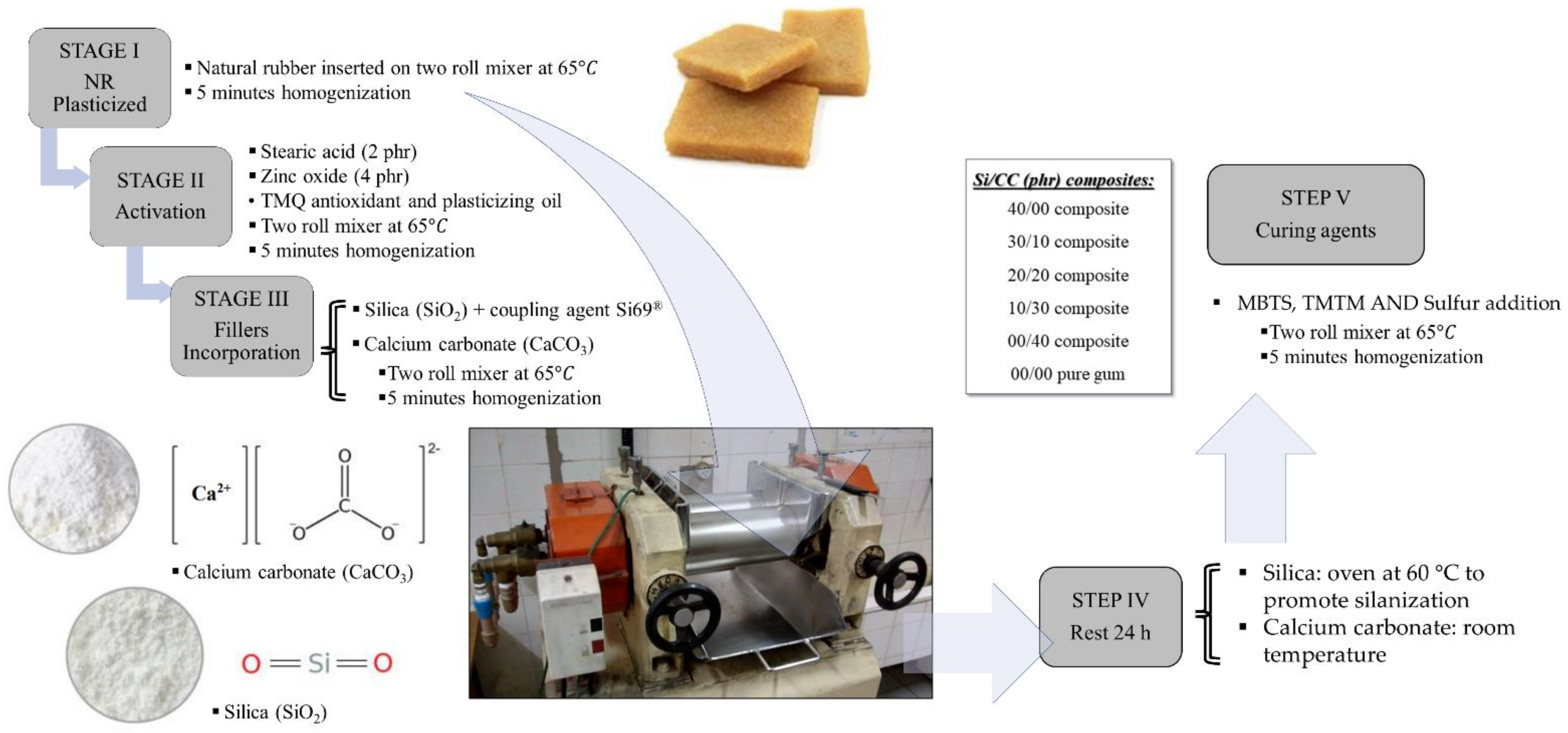


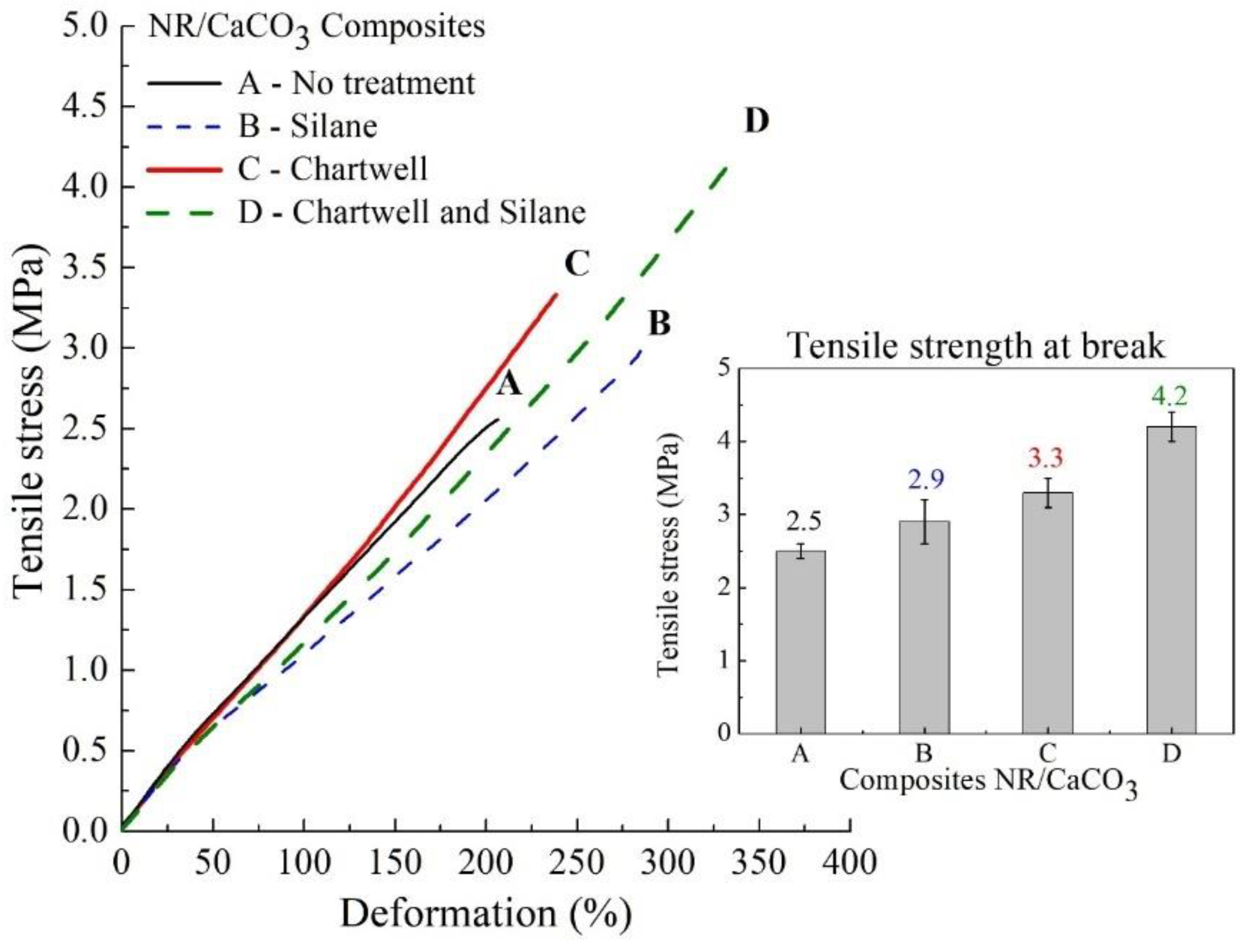


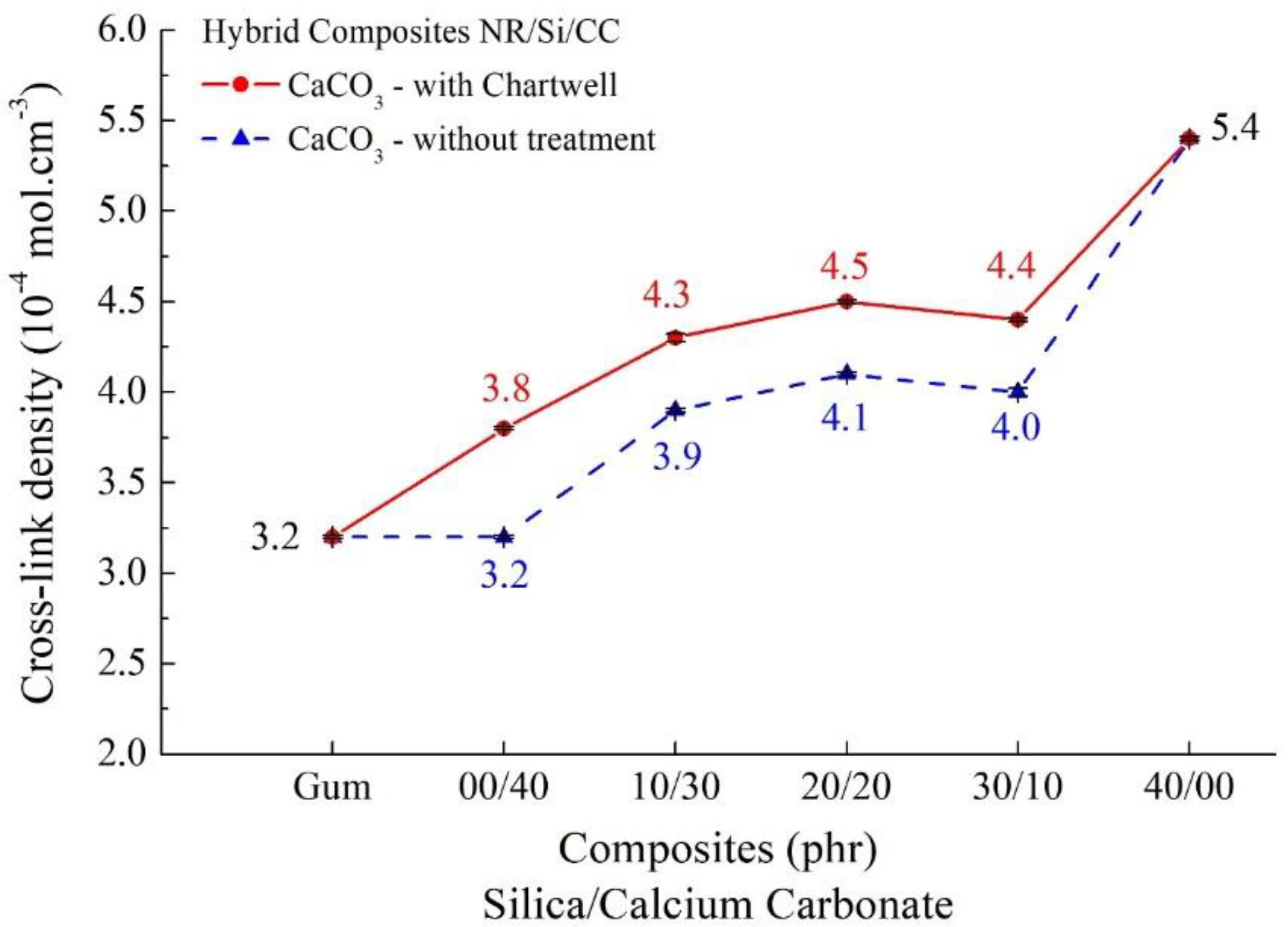
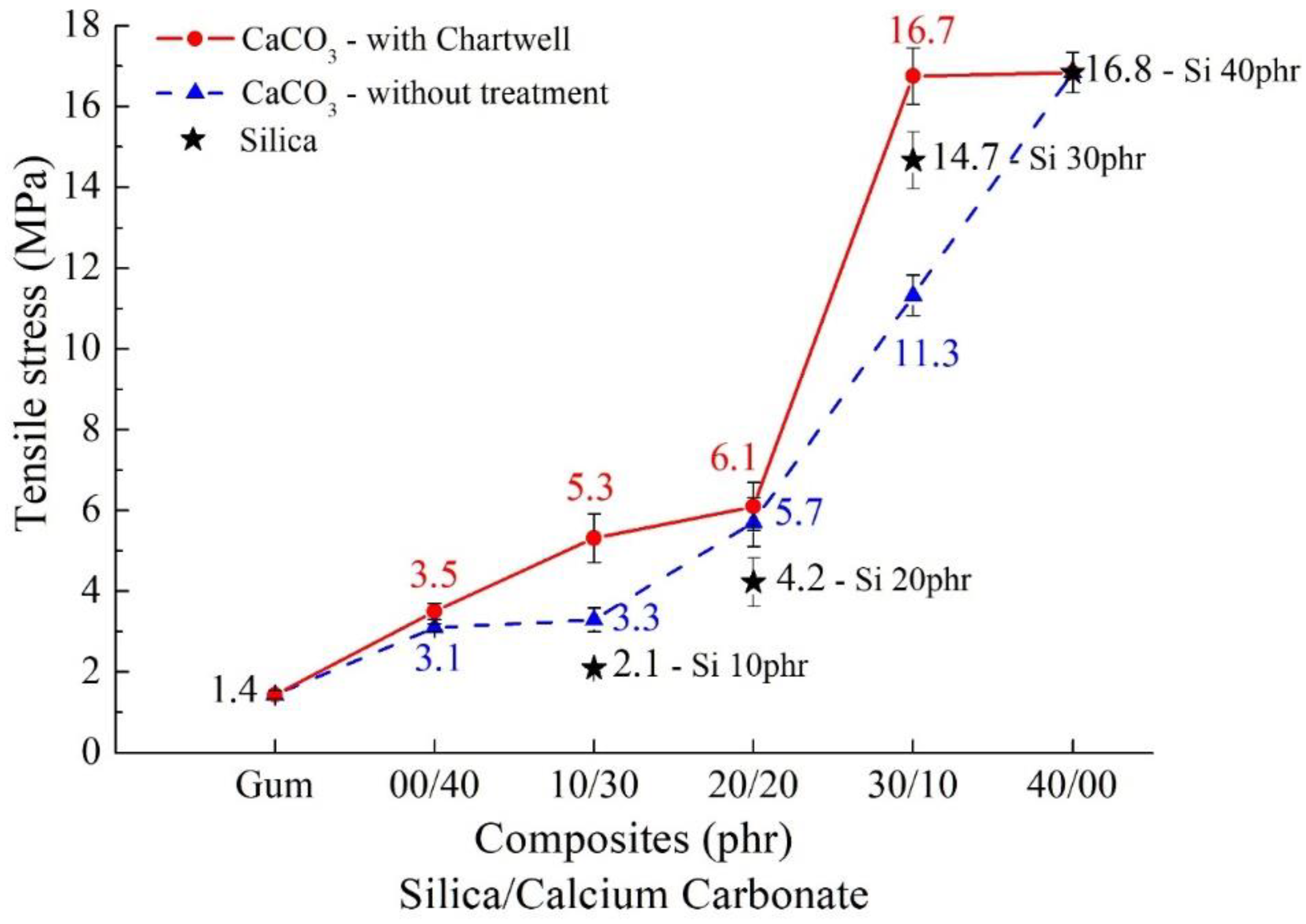



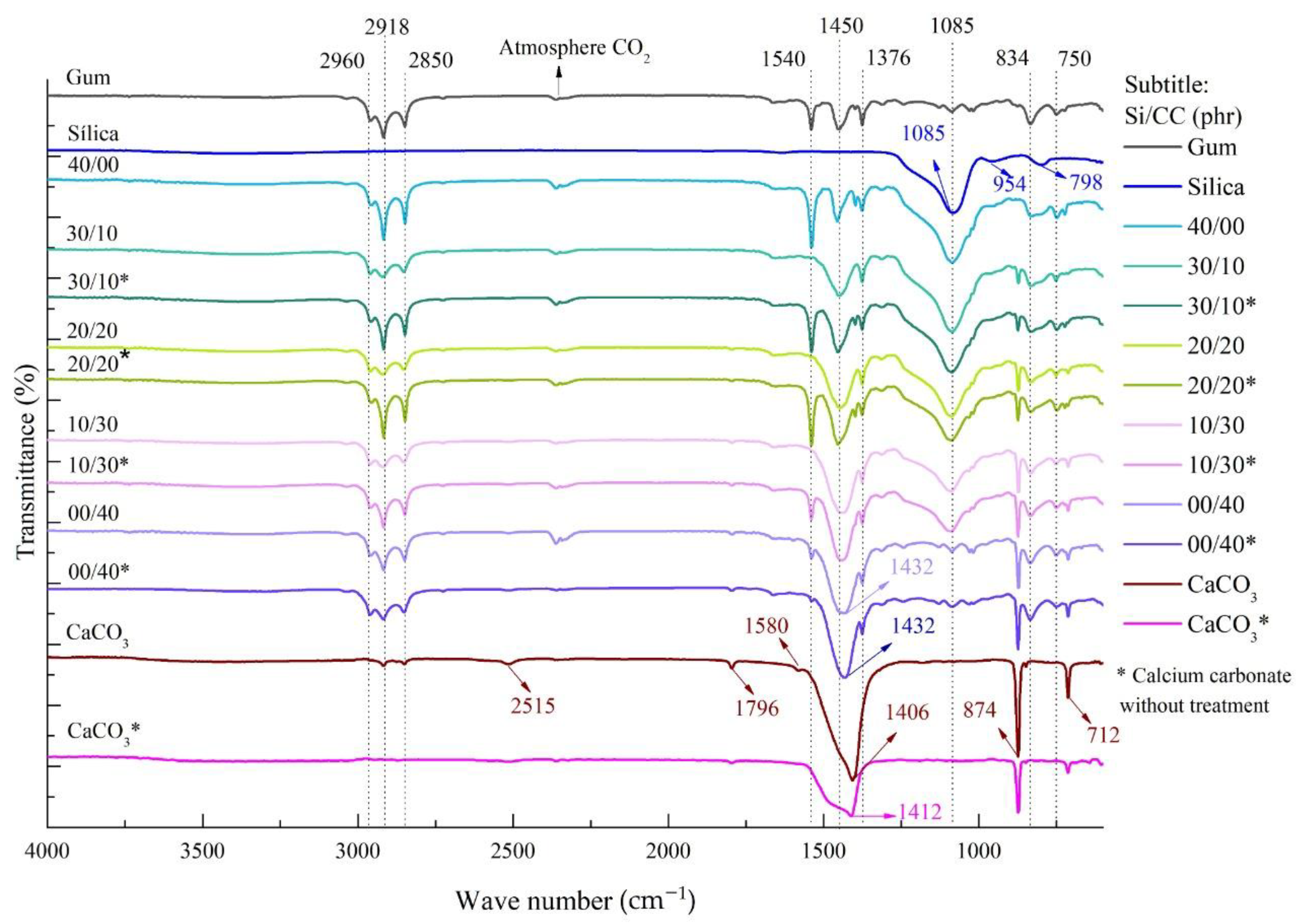
| Materials and Reagents | Quantity (phr) | Density (g cm−3) | Component | |
|---|---|---|---|---|
| 1st Stage | Natural Rubber | 100 | 0.95 | Polymeric matrix |
| Stearic acid | 2 | 0.85 | Activator | |
| Zinc oxide | 4 | 5.57 | Activator | |
| TMQ antioxidant | 1 | 1.20 | Additive | |
| Plasticizing oil | 5 | 0.84 | Additive | |
| Silica (SiO2) + Si69® | 40–00 | 2.10 | Filler | |
| Calcium carbonate (CaCO3) | 00–40 | 2.71 | Filler | |
| 2nd St. | MBTS a | 2.5 | 1.53 | Main accelerator |
| TMTM b | 0.5 | 1.4 | Secondary accelerator | |
| Sulfur | 2.5 | 2.07 | Curing agent | |
| Composite (Si/CaCO3) | Density (g cm−3) |
|---|---|
| Gum 00/00 | 0.99 |
| 40/00 | 1.15 |
| 30/10 | 1.16 |
| 20/20 | 1.17 |
| 10/30 | 1.18 |
| 00/40 | 1.19 |
| Composites | ts1 | t90 | Δt | ML | MH | ΔM |
|---|---|---|---|---|---|---|
| (s) | (s) | (s) | (dN.m) | (dN.m) | (dN.m) | |
| Gum | 192 ± 0.6 | 252 ± 4.7 | 60 ± 5 | 2.4 ± 0.1 | 26 ± 1.7 | 24 ± 1.8 |
| A-CaCO3 without treatment | 178 ± 0.5 | 208 ± 0.5 | 30 ± 1 | 1.9 ± 0.1 | 31 ± 0.2 | 29 ± 0.3 |
| B-CaCO3 with silane | 169 ± 7.0 | 213 ± 4.0 | 44 ± 6 | 1.9 ± 0.1 | 30 ± 1.4 | 28 ± 1.5 |
| C-CaCO3 with Chartwell® | 148 ± 0.5 | 173 ± 1.5 | 25 ± 2 | 1.7 ± 0,1 | 35 ± 0.4 | 33 ± 0.5 |
| D-CaCO3 with Chartwell® and silane | 161 ± 1.0 | 209 ± 5.0 | 48 ± 6 | 1.9 ± 0,1 | 31 ± 1.2 | 29 ± 1.3 |
| Hybrid Composite | ts1 | t90 | Δt | ML | MH | ΔM |
|---|---|---|---|---|---|---|
| (phr) | (s) | (s) | (s) | (dN m) | (dN m) | (dN m) |
| Gum | 212 ± 1.0 | 262 ± 7.2 | 50 ± 8.2 | 2.6 ± 0.2 | 29 ± 1.9 | 27 ± 2.1 |
| 00/40 (Si/CC) | 158 ± 2.3 | 203 ± 3.2 | 45 ± 5.5 | 2.5 ± 0.1 | 41 ± 1.1 | 38 ± 1.2 |
| 10/30 (Si/CC) | 146 ± 2.8 | 184 ± 1.4 | 38 ± 4.2 | 3.0 ± 0.1 | 45 ± 1.4 | 42 ± 1.5 |
| 20/20 (Si/CC) | 150 ± 2.1 | 189 ± 1.4 | 39 ± 3.5 | 2.6 ± 0.4 | 47 ± 0.6 | 45 ± 1.0 |
| 30/10 (Si/CC) | 162 ± 4.7 | 211 ± 10.6 | 49 ± 15.3 | 3.0 ± 0.2 | 43 ± 3.1 | 40 ± 3.3 |
| 40/00 (Si/CC) | 224 ± 7.7 | 306 ± 9.3 | 82 ± 17.0 | 3.4 ± 0.2 | 44 ± 4.4 | 41 ± 4.6 |
| Wavenumber (cm–1) | Assignment | References |
|---|---|---|
| Natural Rubber (cis-1,4-polyisoprene) | ||
| 2960 | Asymmetric axial deformation—C-H | [59,60,61] |
| 2918 | Asymmetric stretch—CH3 | [59,60,61] |
| 2850 | Symmetric stretch—CH3 | [59,60,61] |
| 1540 | Symmetric axial deformation—C = C | [47,48] |
| 1450 | Asymmetric angular deformation—CH2 | [62,63,64,65,66] |
| 1376 | Symmetric angular deformation—CH3 | [62,63,64,65,66] |
| 834 | Link bending—C = CH | [62,63,64,65,66] |
| 750 | Twist—CH2 | [64] |
| Silica-Silicon dioxide-SiO2 | ||
| 1085 | Asymmetric stretch—O-Si-O | [76,77] |
| 954 | Symmetric stretch—O-Si-O | [76,77] |
| 798 | Symmetric stretch—O-Si-O | [76,77] |
| Calcium carbonate-Carbon dioxide-CaCO3 | ||
| 1406 | Amorphous phase vibration—CO3 | [70,71,72,73] |
| 874 | Asymmetric axial deformation—CO3 | [70,71,72,73] |
| 712 | Symmetric axial deformation—CO3 | [70,71,72,73] |
Publisher’s Note: MDPI stays neutral with regard to jurisdictional claims in published maps and institutional affiliations. |
© 2022 by the authors. Licensee MDPI, Basel, Switzerland. This article is an open access article distributed under the terms and conditions of the Creative Commons Attribution (CC BY) license (https://creativecommons.org/licenses/by/4.0/).
Share and Cite
Ribeiro, G.D.; Hiranobe, C.T.; da Silva, J.F.R.; Torres, G.B.; Paim, L.L.; Job, A.E.; Cabrera, F.C.; dos Santos, R.J. Physical-Mechanical Properties of Chartwell® Coupling Agent-Treated Calcium Carbonate and Silica-Reinforced Hybrid Natural Rubber Composites. Crystals 2022, 12, 1552. https://doi.org/10.3390/cryst12111552
Ribeiro GD, Hiranobe CT, da Silva JFR, Torres GB, Paim LL, Job AE, Cabrera FC, dos Santos RJ. Physical-Mechanical Properties of Chartwell® Coupling Agent-Treated Calcium Carbonate and Silica-Reinforced Hybrid Natural Rubber Composites. Crystals. 2022; 12(11):1552. https://doi.org/10.3390/cryst12111552
Chicago/Turabian StyleRibeiro, Gabriel Deltrejo, Carlos Toshiyuki Hiranobe, José Francisco Resende da Silva, Giovanni Barrera Torres, Leonardo Lataro Paim, Aldo Eloizo Job, Flávio Camargo Cabrera, and Renivaldo José dos Santos. 2022. "Physical-Mechanical Properties of Chartwell® Coupling Agent-Treated Calcium Carbonate and Silica-Reinforced Hybrid Natural Rubber Composites" Crystals 12, no. 11: 1552. https://doi.org/10.3390/cryst12111552
APA StyleRibeiro, G. D., Hiranobe, C. T., da Silva, J. F. R., Torres, G. B., Paim, L. L., Job, A. E., Cabrera, F. C., & dos Santos, R. J. (2022). Physical-Mechanical Properties of Chartwell® Coupling Agent-Treated Calcium Carbonate and Silica-Reinforced Hybrid Natural Rubber Composites. Crystals, 12(11), 1552. https://doi.org/10.3390/cryst12111552








